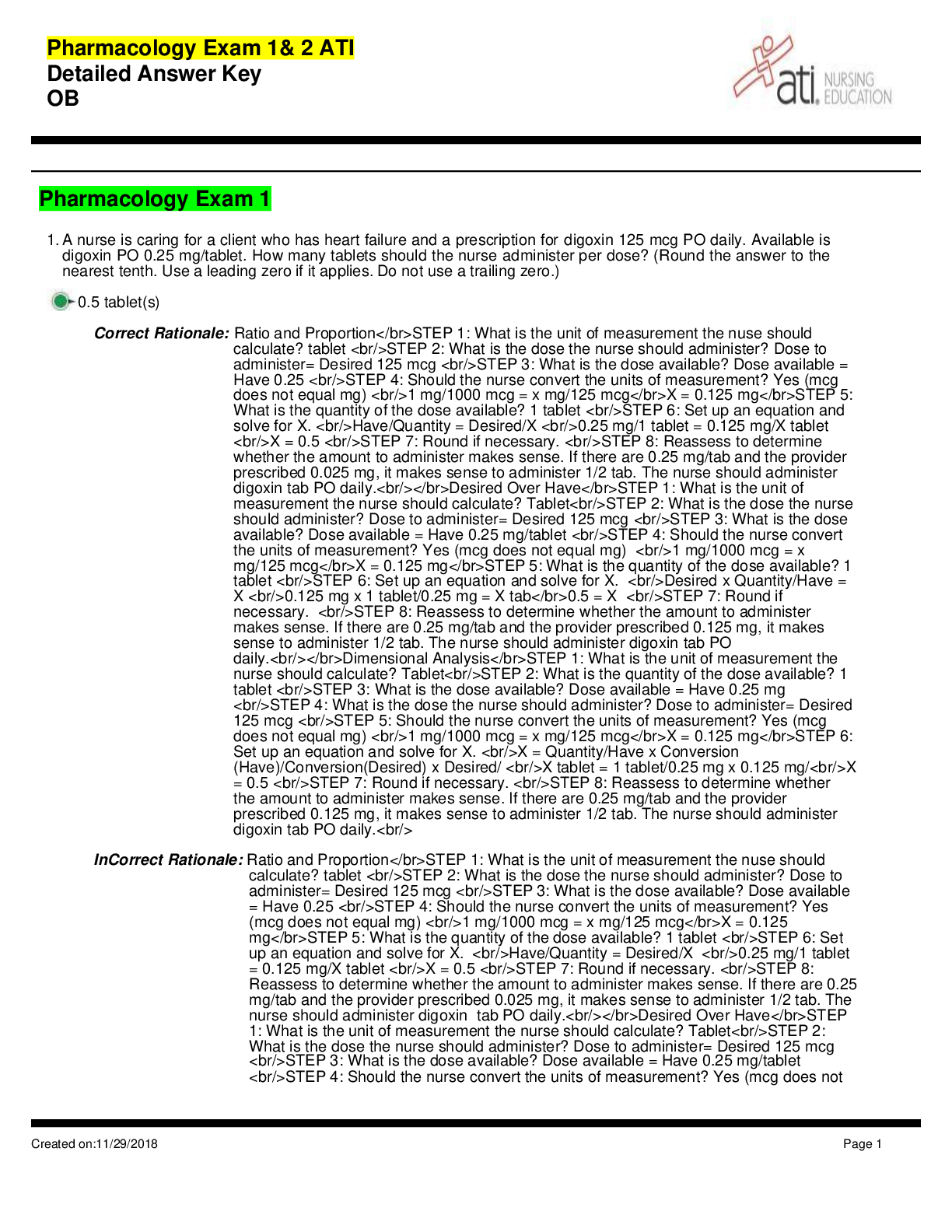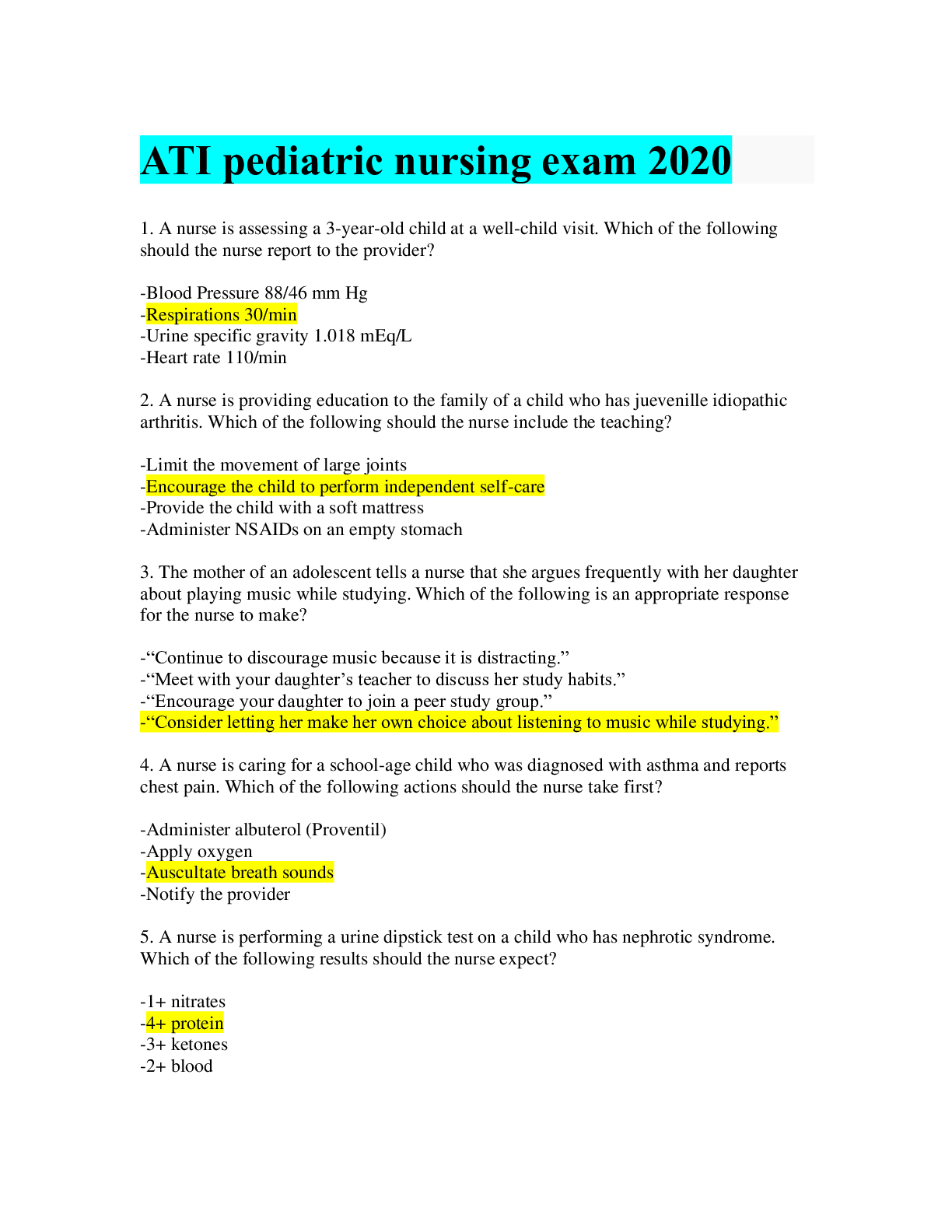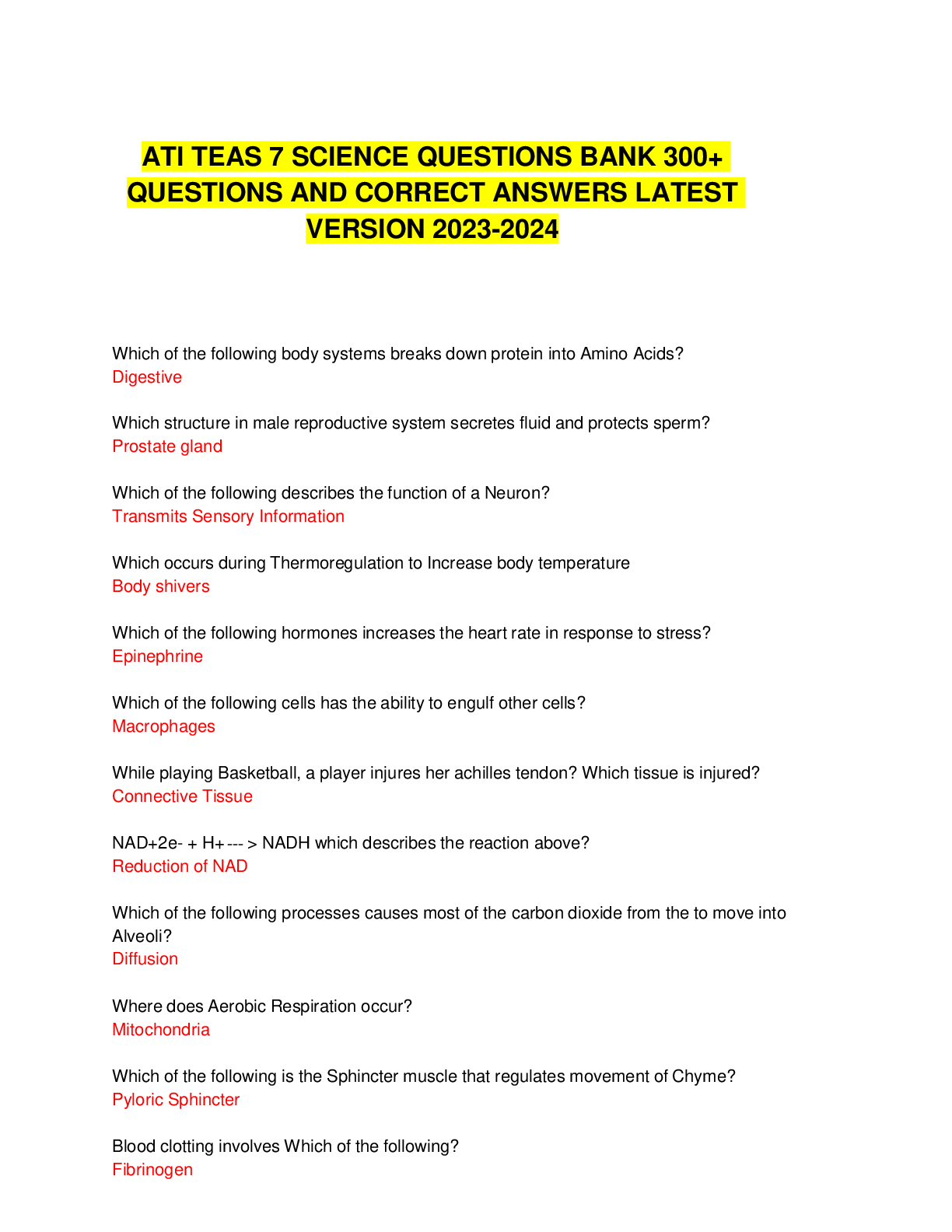*NURSING > QUESTIONS and ANSWERS > (answered/rationales) Pharmacology Exam 1& 2 ATI Detailed Answer Key OB Test Bank_ Complete. (All)
(answered/rationales) Pharmacology Exam 1& 2 ATI Detailed Answer Key OB Test Bank_ Complete.
Document Content and Description Below
(answered/rationales) Pharmacology Exam 1& 2 ATI Detailed Answer Key OB Test Bank_ Complete. Pharmacology Exam 1 1. A nurse is caring for a client who has heart failure and a prescription for di... goxin 125 mcg PO daily. Available is digoxin PO 0.25 mg/tablet. How many tablets should the nurse administer per dose? (Round the answer to the nearest tenth. Use a leading zero if it applies. Do not use a trailing zero.) 0.5 tablet(s) Correct Rationale: Ratio and Proportion</br>STEP 1: What is the unit of measurement the nuse should calculate? tablet <br/>STEP 2: What is the dose the nurse should administer? Dose to administer= Desired 125 mcg <br/>STEP 3: What is the dose available? Dose available = Have 0.25 <br/>STEP 4: Should the nurse convert the units of measurement? Yes (mcg does not equal mg) <br/>1 mg/1000 mcg = x mg/125 mcg</br>X = 0.125 mg</br>STEP 5: What is the quantity of the dose available? 1 tablet <br/>STEP 6: Set up an equation and solve for X. <br/>Have/Quantity = Desired/X <br/>0.25 mg/1 tablet = 0.125 mg/X tablet <br/>X = 0.5 <br/>STEP 7: Round if necessary. <br/>STEP 8: Reassess to determine whether the amount to administer makes sense. If there are 0.25 mg/tab and the provider prescribed 0.025 mg, it makes sense to administer 1/2 tab. The nurse should administer digoxin tab PO daily.<br/></br>Desired Over Have</br>STEP 1: What is the unit of measurement the nurse should calculate? Tablet<br/>STEP 2: What is the dose the nurse should administer? Dose to administer= Desired 125 mcg <br/>STEP 3: What is the dose available? Dose available = Have 0.25 mg/tablet <br/>STEP 4: Should the nurse convert the units of measurement? Yes (mcg does not equal mg) <br/>1 mg/1000 mcg = x mg/125 mcg</br>X = 0.125 mg</br>STEP 5: What is the quantity of the dose available? 1 tablet <br/>STEP 6: Set up an equation and solve for X. <br/>Desired x Quantity/Have = X <br/>0.125 mg x 1 tablet/0.25 mg = X tab</br>0.5 = X <br/>STEP 7: Round if necessary. <br/>STEP 8: Reassess to determine whether the amount to administer makes sense. If there are 0.25 mg/tab and the provider prescribed 0.125 mg, it makes sense to administer 1/2 tab. The nurse should administer digoxin tab PO daily.<br/></br>Dimensional Analysis</br>STEP 1: What is the unit of measurement the nurse should calculate? Tablet<br/>STEP 2: What is the quantity of the dose available? 1 tablet <br/>STEP 3: What is the dose available? Dose available = Have 0.25 mg <br/>STEP 4: What is the dose the nurse should administer? Dose to administer= Desired 125 mcg <br/>STEP 5: Should the nurse convert the units of measurement? Yes (mcg does not equal mg) <br/>1 mg/1000 mcg = x mg/125 mcg</br>X = 0.125 mg</br>STEP 6: Set up an equation and solve for X. <br/>X = Quantity/Have x Conversion (Have)/Conversion(Desired) x Desired/ <br/>X tablet = 1 tablet/0.25 mg x 0.125 mg/<br/>X = 0.5 <br/>STEP 7: Round if necessary. <br/>STEP 8: Reassess to determine whether the amount to administer makes sense. If there are 0.25 mg/tab and the provider prescribed 0.125 mg, it makes sense to administer 1/2 tab. The nurse should administer digoxin tab PO daily.<br/> InCorrect Rationale: Ratio and Proportion</br>STEP 1: What is the unit of measurement the nuse should calculate? tablet <br/>STEP 2: What is the dose the nurse should administer? Dose to administer= Desired 125 mcg <br/>STEP 3: What is the dose available? Dose available = Have 0.25 <br/>STEP 4: Should the nurse convert the units of measurement? Yes (mcg does not equal mg) <br/>1 mg/1000 mcg = x mg/125 mcg</br>X = 0.125 mg</br>STEP 5: What is the quantity of the dose available? 1 tablet <br/>STEP 6: Set up an equation and solve for X. <br/>Have/Quantity = Desired/X <br/>0.25 mg/1 tablet = 0.125 mg/X tablet <br/>X = 0.5 <br/>STEP 7: Round if necessary. <br/>STEP 8: Reassess to determine whether the amount to administer makes sense. If there are 0.25 mg/tab and the provider prescribed 0.025 mg, it makes sense to administer 1/2 tab. The nurse should administer digoxin tab PO daily.<br/></br>Desired Over Have</br>STEP 1: What is the unit of measurement the nurse should calculate? Tablet<br/>STEP 2: What is the dose the nurse should administer? Dose to administer= Desired 125 mcg <br/>STEP 3: What is the dose available? Dose available = Have 0.25 mg/tablet <br/>STEP 4: Should the nurse convert the units of measurement? Yes (mcg does not s not equal mg) <br/>1 mg/1000 mcg = x mg/125 mcg</br>X = 0.125 mg</br>STEP 5: What is the quantity of the dose available? 1 tablet <br/>STEP 6: Set up an equation and solve for X. <br/>Desired x Quantity/Have = X <br/>0.125 mg x 1 tablet/0.25 mg = X tab</br>0.5 = X <br/>STEP 7: Round if necessary. <br/>STEP 8: Reassess to determine whether the amount to administer makes sense. If there are 0.25 mg/tab and the provider prescribed 0.125 mg, it makes sense to administer 1/2 tab. The nurse should administer digoxin tab PO daily.<br/></br>Dimensional Analysis</br>STEP 1: What is the unit of measurement the nurse should calculate? Tablet<br/>STEP 2: What is the quantity of the dose available? 1 tablet <br/>STEP 3: What is the dose available? Dose available = Have 0.25 mg <br/>STEP 4: What is the dose the nurse should administer? Dose to administer= Desired 125 mcg <br/>STEP 5: Should the nurse convert the units of measurement? Yes (mcg does not equal mg) <br/>1 mg/1000 mcg = x mg/125 mcg</br>X = 0.125 mg</br>STEP 6: Set up an equation and solve for X. <br/>X = Quantity/Have x Conversion (Have)/Conversion(Desired) x Desired/ <br/>X tablet = 1 tablet/0.25 mg x 0.125 mg/<br/>X = 0.5 <br/>STEP 7: Round if necessary. <br/>STEP 8: Reassess to determine whether the amount to administer makes sense. If there are 0.25 mg/tab and the provider prescribed 0.125 mg, it makes sense to administer 1/2 tab. The nurse should administer digoxin tab PO daily.<br/> 2. A nurse is planning to apply a transdermal analgesic cream prior to inserting an IV for a preschool-age child. Which of the following actions should the nurse plan to take? (Select all that apply.) A. Spread the cream over the lateral surface of both forearms. B. Apply to intact skin. C. Apply the medication an hour before the procedure begins. D. Cleanse the skin prior to procedure. E. Use a visual pain rating scale to evaluate effectiveness of the treatment. Rationale: <b>Spread the cream over the lateral surface of both forearms is incorrect.</b> The nurse should apply the smallest amount of cream to the smallest area required to reduce the risk for systemic toxicity. Systemic effects of the anesthetic include bradycardia, heart block, and seizures.</br></br><b>Apply to intact skin is correct.</b> The nurse should apply cream over intact skin to reduce the risk for systemic toxicity. The nurse should wear gloves while applying the cream to reduce the risk of absorbing the anesthetic.</br></br><b>Apply the medication an hour before the procedure begins is correct.</b> The nurse should allow 30 min to 1 hr for the topical analgesic to take effect.</br></br><b>Cleanse the skin prior to procedure is correct.</b> Apply the topical analgesic to clean skin to increase absorption.</br></br><b>Use a visual pain rating scale to evaluate effectiveness of the treatment is correct.</b> A childs response and understanding of pain depends on the childs age and stage of development. A preschooler might be unable to describe pain due to a limited vocabulary. Use a visual scale (FACES or OUCHER Scale) with faces or colors to assess evaluate the effectiveness of the treatment. 3. A nurse is providing instructions about bowel cleansing with polyethylene glycol-electrolyte solution (PEG) for a client who is going to have a colonoscopy. Which of the following information should the nurse include? A. "To prevent dehydration, drink an additional liter of fluid during preparation time." Rationale: Dehydration does not occur with PEG. No additional fluid intake is necessary. B. "Expect bowel movements to begin 3 hr following completion of solution." Rationale: Bowel movements begin about 1 hr following the first dose. C. "Abdominal bloating might occur." Rationale: While PEG is well-tolerated, adverse effects include nausea, bloating, and abdominal discomfort. D. "Drink 400 mL every hour until bowel movements are clear." Rationale: The client should ingest the full solution by drinking 250 mL to 300 mL every 10 minutes over 2 to 3 hr. 4. A nurse is preparing to administer amoxicillin 30 mg/kg/day divided equally every 12 hr to a toddler who weighs 32 lb (14.5 kg). Available is amoxicillin 200 mg/5 mL suspension. How many mL should the nurse administer? (Round the answer to the nearest tenth. Use a leading zero if it applies. Do not use a trailing zero.) 5.5 mL Correct Rationale: <b>Follow these steps for the preliminary conversions:</b></br>STEP 1: What is the unit of measurement the nurse should calculate? mg<br/>STEP 2: Set up an equation and solve for X. <br/>mg x kg/day = X <br/>30 mg X 14.5 kg/day = 435 mg <br/>STEP 3: Round if necessary.<br/>STEP 4: Reassess to determine whether the amount makes sense. If the prescription reads 30 mg/kg/day to divide equally every 12 hr and the toddler weighs 14.5 kg, it makes sense to give 435 mg/day or 218 mg every 12 hr. <br/></br><b>Ratio and Proportion</b><br>STEP 1: What is the unit of measurement the nurse should calculate? mL <br/>STEP 2: What is the dose the nurse should administer? Dose to administer = Desired 218 mg <br/> STEP 3: What is the dose available? Dose available = Have 200 mg <br/>STEP 4: Should the nurse convert the units of measurement? No <br/>STEP 5: What is the quantity of the dose available? 5 mL <br/>STEP 6: Set up an equation and solve for X. <br/>Have/Quantity = Desired/X <br/>200 mg/5 mL = 218 mg/X mL <br/>X = 5.45 mL <br/>STEP 7: Round if necessary. 5.45 = 5.5 mL <br/>STEP 8: Reassess to determine whether the amount to give makes sense. If there is 200 mg/5 mL and the prescription reads 218 mg, it makes sense to give 5.5 mL. The nurse should administer amoxicillin oral solution 5.5 mL PO every 12 hr. <br/><br><b>Desired Over Have</b><br>STEP 1: What is the unit of measurement the nurse should calculate? mL <br/>STEP 2: What is the dose the nurse should administer? Dose to administer = Desired 218 mg <br/> STEP 3: What is the dose available? Dose available = Have 200 mg <br/>STEP 4: Should the nurse convert the units of measurement? No <br/>STEP 5: What is the quantity of the dose available? 5 mL <br/>STEP 6: Set up an equation and solve for X. <br/>Desired X Quantity/Have = X <br/>218 mg X 5 mL/ 200 mg = X <br/>5.45 mL = X <br/>STEP 7: Round if necessary. 5.45 = 5.5 mL <br/>STEP 8: Reassess to determine whether the amount to give makes sense. If there is 200 mg/5 mL and the prescription reads 218 mg, it makes sense to give 5.5 mL. The nurse should administer dexamethasone oral solution 5.5 mL PO every 12 hr.</br><br><b>Dimensional Analysis</b><br>STEP 1: What is the unit of measurement the nurse should calculate? mL <br/>STEP 2: What Quantity of the dose is available? 5 mL <br/> STEP 3: What is the dose available? Dose available = Have 200 mg <br/>STEP 4: What is the dose the nurse should administer? Dose to administer = Desired 218 mg <br/> STEP 5: Should the nurse convert the units of measurement? No <br/>STEP 6: Set up an equation and solve for X. <br/>X = Quantity/ Have X Conversion Conversion (Have)/ Conversion (Desired) X Desired/ <br/>X mL = 5 mL/ 200 mg X 218 mg/<br>X = 5.45 <br/>STEP 7: Round if necessary. 5.45 = 5.5 mL <br/>STEP 8: Reassess to determine whether the amount to give makes sense. If there is 200 mg/5 mL and the prescription reads 218 mg, it makes sense to give 5.5 mL. The nurse should administer amoxicillin 5.5 mL PO every 12 hr.</br> InCorrect Rationale: <b>Follow these steps for the preliminary conversions:</b></br>STEP 1: What is the unit of measurement the nurse should calculate? mg<br/>STEP 2: Set up an equation and solve for X. <br/>mg x kg/day = X <br/>30 mg X 14.5 kg/day = 435 mg <br/>STEP 3: Round if necessary.<br/>STEP 4: Reassess to determine whether the amount makes sense. If the prescription reads 30 mg/kg/day to divide equally every 12 hr and the toddler weighs 14.5 kg, it makes sense to give 435 mg/day or 218 mg every 12 hr. <br/></br><b>Ratio and Proportion</b><br>STEP 1: What is the unit of measurement the nurse should calculate? mL <br/>STEP 2: What is the dose the nurse should administer? Dose to administer = Desired 218 mg <br/> STEP 3: What is the dose available? Dose available = Have 200 mg <br/>STEP 4: Should the nurse convert the units of measurement? No <br/>STEP 5: What is the quantity of the dose available? 5 mL <br/>STEP 6: Set up an equation and solve for X. <br/>Have/Quantity = Desired/X <br/>200 mg/5 mL = 218 mg/X mL <br/>X = 5.45 mL <br/>STEP 7: Round if necessary. 5.45 = 5.5 mL <br/>STEP 8: Reassess to determine whether the amount to give makes sense. If there is 200 mg/5 mL and the prescription reads 218 mg, it makes sense to give 5.5 mL. The nurse should administer amoxicillin oral solution 5.5 mL PO every 12 hr. <br/><br><b>Desired Over Have</b><br>STEP 1: What is the unit of measurement the nurse should calculate? mL <br/>STEP 2: What is the dose the nurse should administer? Dose to administer = Desired 218 mg <br/> STEP 3: What is the dose available? Dose available = Have 200 mg <br/>STEP 4: Should the nurse convert the units of measurement? No <br/>STEP 5: What is the quantity of the dose available? 5 mL <br/>STEP 6: Set up an equation and solve for X. <br/>Desired X Quantity/Have = X <br/>218 mg X 5 mL/ 200 mg = X <br/>5.45 mL = X <br/>STEP 7: Round if necessary. 5.45 = 5.5 mL <br/>STEP 8: Reassess to determine whether the amount to give makes sense. If there is 200 mg/5 mL and the prescription reads 218 mg, it makes sense to give 5.5 mL. The nurse should administer dexamethasone oral solution 5.5 mL PO every 12 hr.</br><br><b>Dimensional Analysis</b><br>STEP 1: What is the unit of measurement the nurse should calculate? mL <br/>STEP 2: What Quantity of the dose is available? 5 mL <br/> STEP 3: What is the dose available? Dose available = Have 200 mg <br/>STEP 4: What is the dose the nurse should administer? Dose to administer = Desired 218 mg <br/> STEP 5: Should the nurse convert the units of measurement? No <br/>STEP 6: Set up an equation and solve for X. <br/>X = Quantity/ Have X Conversion (Have)/ Conversion (Desired) X Desired/ <br/>X mL = 5 mL/ 200 mg X 218 mg/<br>X = 5.45 <br/>STEP 7: Round if necessary. 5.45 = 5.5 mL <br/>STEP 8: Reassess to determine whether the amount to give makes sense. If there is 200 mg/5 mL and the prescription reads 218 mg, it makes sense to give 5.5 mL. The nurse should administer amoxicillin 5.5 mL PO every 12 hr.</br> 5. A nurse is caring for a 4-year-old child who is resistant to taking medication. Which of the following strategies should the nurse use to elicit the child's cooperation? A. Offer the child a choice of taking the medication with juice or water. Rationale: While taking the medicine is not a choice, the child can decide what kind of fluid to take with the medication. This gives the preschool-aged child a sense of control over a stressful situation and increases the child's ability to cope. B. Tell the child it is candy. Rationale: Continues................ [Show More]
Last updated: 2 years ago
Preview 1 out of 249 pages

Buy this document to get the full access instantly
Instant Download Access after purchase
Buy NowInstant download
We Accept:

Reviews( 0 )
$20.00
Can't find what you want? Try our AI powered Search
Document information
Connected school, study & course
About the document
Uploaded On
May 23, 2021
Number of pages
249
Written in
Additional information
This document has been written for:
Uploaded
May 23, 2021
Downloads
0
Views
110


.png)
Perop.png)





.png)



